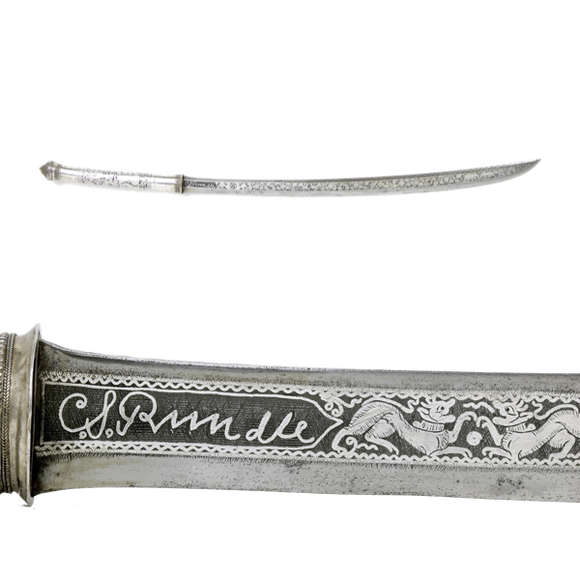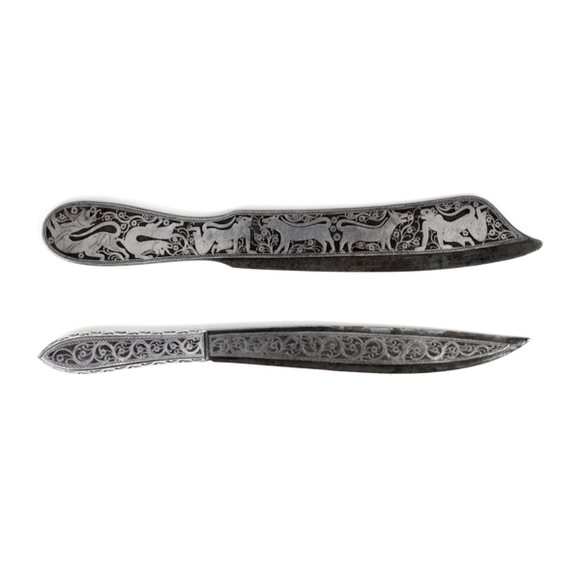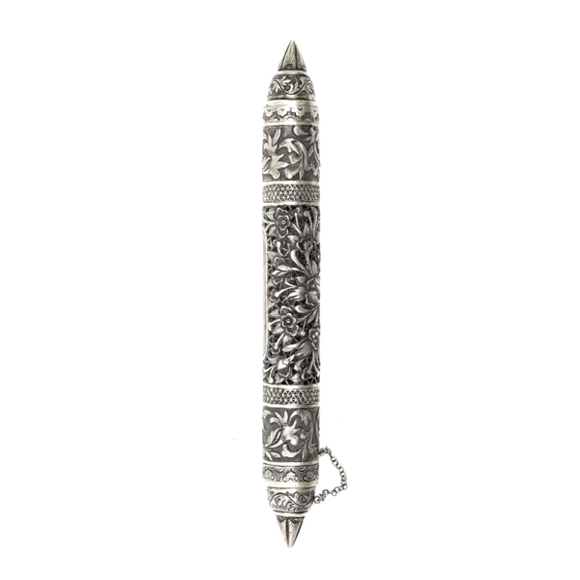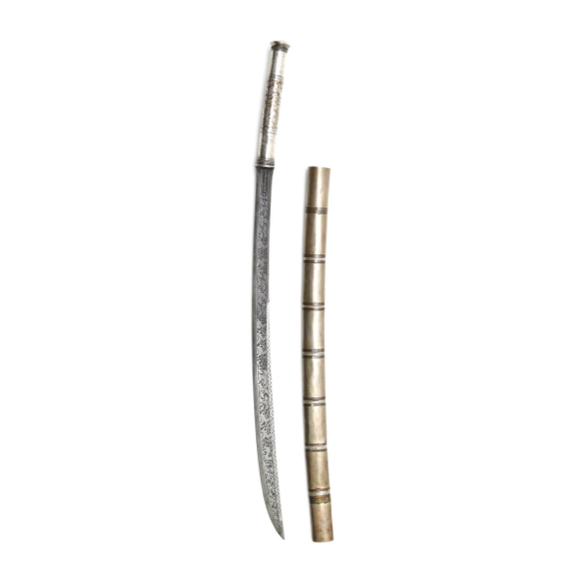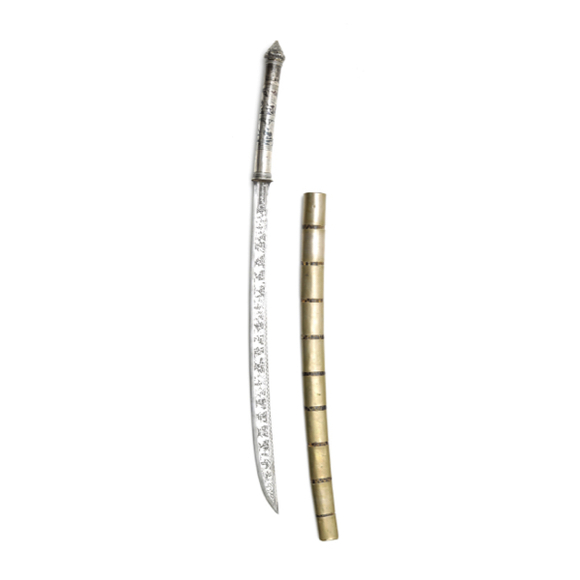Language: Burmese
Source: Period accounts and dictionaries
Description
Da (ဓား) in Burmese means sword, knife or chopper.
Dha is in common use among English speaking collectors, but da is the official transcription. I will use both on this website.
The word dha is often used by collectors to describe a type of sword that was used by various ethnic groups living in Burma, Yunnan, Thailand, Cambodia and Laos. Among English speaking collectors, the word dha usually refers to the sword, the daggers being referred to as dha-knife.
The typical dha has a slightly curved blade that gently widens at the tip. It has a round cross-section hilt and usually no guard, although there are exceptions primarily among Thai and Vietnamese varieties. Tips are usually pointy but can be concave or clipped.
There are also straight examples, often with concave or flat tips, which are mainly associated with the various people living in the Kachin states of northern Burma.
Some variety of dha used by peoples of Burma
The Burmese dha
 A typical example with good, heavy blade. Often heavy blades with a center groove and a long back bevel.
A typical example with good, heavy blade. Often heavy blades with a center groove and a long back bevel.
Sold by Mandarin Mansion in 2019.
Mindan dha

A variation of the typical Burmese dha, now with lavish silver overlay.
Produced in Mindan village, Yamethin district.
Sold by Mandarin Mansion in 2019.
Shan minority dha
 Typical Shan style workmanship on this sword.
Typical Shan style workmanship on this sword.
A further confirmation or origin comes from Shan script on the pommel.
Sold by Mandarin Mansion in 2019.
Northern Shan dha with Kachin influence
 A so-called Kachin dha. Other than the blade shape, the style and workmanship points to the Shan.
A so-called Kachin dha. Other than the blade shape, the style and workmanship points to the Shan.
These were said to be used by Shans and peoples at the northern frontier.
Sold at Mandarin Mansion in 2019.
Chinese Shan/Dai minority presentation dha
 Chinese Shan presentation dha.
Chinese Shan presentation dha.
Presented by the brother of a Yunnanese Dai minority chief to a British custom's official.
Listed at Mandarin Mansion in 2019.
Lin gin (လင်းကင်း), also known as "Kachin dha"
Short dha with concave tips in open scabbards worn by many minorities in the north. Historically known as Linkin dha or Hkampti dha after their intended market. Made by blacksmiths in the far north of Kachin state, they were widely traded and worn by a variety of people. This included the Jingpo (the largest Kachin population), Khampti Shan, Nung, and also by the Naga of neighboring Assam.
Main article: Lin gin (လင်းကင်း).

A classic linkin dha.
Mandarin Mansion stock 2020.
Husa Valley dha
Made by the Chinese Shans in Husa Valley, Yunnan and widely exported to Burma. Such dha are repeatedly mentioned in sources, the one illustrated below is one of the few existing examples with solid Husa provenance. They probably produced several varieties, and in cases only blades were exported and mounted elsewhere.
Main article: Husa Valley dha.

A dha collected in the Husa Valley, Yunnan, by John Andersen in 1871.
British Museum collection.
Spelling
Depending on the transliteration system used, alternative spellings are dah, da and dah. Today, dha is most commonly used among collectors.
Among linguists, da is the prevalent spelling going back from the first Burmese-English dictionary of the early 19th century to the latest official dictionary of 1993.1 The Myanmar Language Commission also standardized the transcription to da.2
In related cultures
The word is quite similar in sound and meaning to the Chinese dāo (刀) to which it is undoubtedly related.
In Thai is is called dāb (ดาบ), also spelled daab or darb in the literature.
In the Jingpo language, the dha is called ninghtu or nhtu.3
Notes to spelling
1. Adoniram Judson; A dictionary of the Burman language, with explanations in English. Printed at the Baptist Mission Press, Circular Road; and sold by Messrs. W. Thacker and Co. St. Andrew's Library, Calcutta; and by the American missionaries in Burmah. 1826. Page 202. Also, Lord Egerton of Tatton; Indian and Oriental Arms and Armour. W. H. Allen & co., limited, London, 1896. Page 95. Dha is used by Archibald Ross Colquhoun in Amongst the Shans, London / New York, Field and Tuer / Scribner and Welford, 1885 and throughout the Gazetteer of Upper Burma and the Shan States.
2. Myanmar-English Dictionary by the Myanmar Language Commission. 1993. A useful online source is the SEAlang Library Burmese Dictionary Resources. All transcriptions are thus in the MLC Transcription System.
3. Henry Felix Hertz; A practical handbook of the Kachin or Chingpaw language. Rangoon, Printed by the Superintendent, Government Printing, Burma. 1902. Page 74.
Other subtypes
Da̱hmjaun (ဓားမြှောင်); dagger.1
Da̱lwe (ဓားလွယ်); a large, fancy dha sword that was worn slung over the shoulder.2
Mainsa dha; most were said to be made in China.3
Notes to subtypes
1. E.N. Bell I.C.S.; A Monograph on Iron and Steel Work in Burma. Rangoon, Superintendent, Government Printing Burma, 1907.
2. Ibid.
3. Ibid.
 A nice example of a dha hmyuang.
A nice example of a dha hmyuang.
Mandarin Mansion, listed 2019.
 A dha-lwe made for british surgeon C.S. Rundle in 1898.
A dha-lwe made for british surgeon C.S. Rundle in 1898.
Sold by Mandarin Mansion in 2019.
Historical mentions
The dha was in universal use among the people of Southeast Asia. Here some mentions in the various literature.
"When a grave, contagious disease appears in a city or a village, the figure of a beloo, or evil monster, is roughly painted on a water-pot, and at the end of the day the pot is broken in pieces by the stroke of a dah, or native sword."
-Louis Vossion; Nat- Worship among the Burmese
American Folklore Society;The Journal of American Folklore
Vol 4, 1891. Pages 107-114.
"As the center of a cavalry district it is not surprising to find that the Meiktila people have a game of tilting. at a pumelo with a spear at full gallop, which corresponds in a way to tent-pegging.
Another feat is to place a chatty on a plantain stem and to cut through the stem with a dha while riding at a gallop, without knocking over the chatty." 1
-Gazetteer of Upper Burma and the Shan States, Part II Volume II, 1901
The inlaid dha and dagger blades of Mindan near Yamèthin are well-known. The dhas are inlaid in gold, silver and brass. 2
-Gazetteer of Upper Burma and the Shan States, Part II Volume II, 1901
Cooking-stands, das and spears alone are manufactured; everything else is imported from China or Myitkyina; and even the das known locally as Mainsa das are largely imported from China. 3
-E.N. Bell, 1907
In the Southern Shan States, Mong-Kung and Kehsi-Mansam das which have a wide reputation even in Siam whither a large number are exported annually under the trade name of Hamngai, the blades being bought wholesale by Hamngai traders who fit them up with handles. 4
-E.N. Bell, 1907
The Yun, or Zimme, Shans are by no means a quarrelsome race, but are subject to sudden outbursts of passion, if they think they are ill-used; and can give an excellent account of their enemies. They are more hardy than either the Siamese or Burmese, and are more manly in their bearing.
In addition to a sturdy staff, not unlike the lattee of India, they habitually carry a dha, or short heavy sabre, and know how to use it, either in cutting their way through the jungle, or in self-defence. When in dangerous districts, or anywhere where danger from man or beast may be expected, they carry, in addition to these, a flint-lock musket or a spear.5
-Archibald Ross Colquhoun, 1885
The Burmese muskets were old flint ones from England, "condemned", the excuse for their being sold to our
enemies; and with the dha a sharp, square-pointed sword with a long wooden handle - and with other weapons, such as a British bayonet stuck on the handle of a spear, the Burmese Infantry equipments were found to be tolerably complete. It may be mentioned that the enemy's musket-ball was found to be considerably smaller than ours, composed of iron as well as lead, not cast in a mould, but rough and varying in size.6
-Colonel W.F.B. Laurie, 1879
Most of the Marines, he observed, were armed with rifles.* One company had the dha, "the national knife, which is almost the same as that terrible weapons of the Afghans, the charah.". Among the extraordinary costumes, he observed the "gilded hats" worn by "spearmen" -many of which kind (worn by the King's troops) we picked up at the capture of Rangoon.
*The stout Burman, with his dhá and Martini-Henry, may yet fight on our side in Upper Burma.7
-Colonel W.F.B. Laurie, 1879
In addition to a sturdy staff, not unlike the lattee of India, they habitually carry a dha, or short heavy sabre, and know how to use it, either in cutting their way through the jungle, or in self-defence. When in dangerous districts, or anywhere where danger from man or beast may be expected, they carry, in addition to these, a flint-lock musket or a spear.
They are considered to be adepts at lying in ambushcades and at night-attacks - are quick of sight and hearing, and creep through the forest in a surprisingly quiet way; their constant life in the woods gives them this advantage. McLeod says that all Shan attacks on their neighbours' villages have been made at night. They never wait to make a regular attack, or fight by day; if they fail in their attempt, they retreat, and watch for a more favourable opportunity.8
-Archibald Ross Colquhoun, 1894.

Illustration from Amongst the Shans.
"Rubies, also, are a sign of rank, and only permitted as ornaments in the swords and cups of the very highest dignitaries. The former point out rank very distinctly, those of the subaltern chieftains having merely silver scabbards and handles, whereas the superior oflicers have theirs made of gold, and often handsomely ornamented with precious stones." 9
-Thomas Abercromby Trant, 1827.
"I must not here omit to notice a curious sight that caught my eye, as we advanced towards the entrenchments. One of the enemy had stationed himself on a mound in their front, on which he was dancing and jumping with an air of defiance, at the same time brandishing a sword, apparently in each hand, and calling out to us in a tone of abuse." 10
-Frederick Brickdale Doveton, between 1824-1826.
"I made signs to them that I had just landed from the ship which was visible coming up the river, and that I was thirsty; whereupon one of them, who had in his dress that wonderful dah -a marvellous bent knife, capable alike of sharpening a lead pencil or of hacking down a tree-climbed a tree with the agility of a monkey, and cut off two of the green cocoa- nuts; then, as rapidly descending, with his dah he cut off the top of one of them and handed to me the most delicious draught I had had for many a long day, cold and refreshing, more than I could drink.
This was my first introduction to the "bloodthirsty " Burman, and I thought then, as I have often done since, how incorrect is the sentiment expressed in dear Bishop Heber's hymn written before he had ever been to India or Ceylon:
"Where every prospect pleases
And only man is vile." " 11
-John Ebenezer Marks, 1917
Notes on historical mentions
1. Sir James George Scott, assisted by John Percy Hardiman; Gazetteer of Upper Burma and the Shan States, Part II Volume II. Superintendent, Government Printing Burma, 1901. Page 279.
2. Ibid. Page 368.
3. E.N. Bell I.C.S.; A Monograph on Iron and Steel Work in Burma. Rangoon, Superintendent, Government Printing Burma, 1907.
4. E.N. Bell I.C.S.; A Monograph on Iron and Steel Work in Burma. Rangoon, Superintendent, Government Printing Burma, 1907.
5. Archibald Ross Colquhoun in Amongst the Shans, London / New York, Field and Tuer / Scribner and Welford, 1885.
6. Colonel William Ferguson Beatson Laurie; Our Burmese wars and relations with Burma: being an abstract of military and political operations, 1824-25-26, and 1852-53. (Second Edition.) W.H. Allen & Co, Publishers to the India Office. London. 1885. Page 131.
7. Ibid.
8. Archibald Ross Colquhoun; Amongst the Shans. New York, Scribner and Welford. 1894. Page 271.
9. Thomas Abercromby Trant; Two Years In Ava (1824-1826). William Clowes, London. 1827. Page 269.
10. Frederick Brickdale Doveton; Reminiscences of the Burmese War, in 1824-5-6. Allen & Co. London. 1852. Page 246.
11. John Ebenezer Marks, Forty years in Burma. London, Hutchinson & Co. Paternoster Row. 1917. Page 49.

